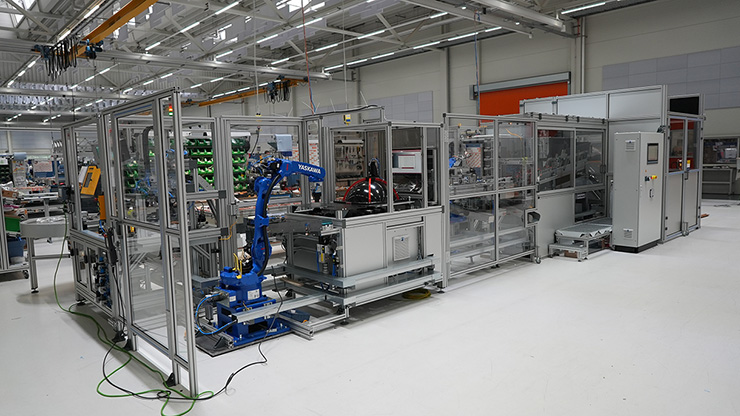The products are initially tipped into a chute via a tilt-tilt device.
One of MiniTec's customers has been active in the field of forming technology for many years. For the automation of processes, the company relies on MiniTec's know-how. In the course of the cooperation, four highly specialized plants have now been designed and built.
Very efficient solutions often result from the cooperation between MiniTec and its customers. One of these customers has been active in the field of forming technology for many years. For the automation of processes, they repeatedly rely on the know-how of MiniTec experts and already have four highly specialized machines in operation. One of them was to be replaced by a new machine after ten years of use.
This was not only to be more powerful and allow a higher throughput, but also to be adapted to the new lathes that were integrated into the plant concept. These were more flexible than the previous ones because they could be expanded and adapted for even higher output. In addition, the products to be machined for the automotive supplier sector had also changed - originally it was only a matter of two products, now the plant had to handle as many as five.

Are you planning a new assembly line or would you like to optimize & automate existing production processes? Then please feel free to contact us!
Accordingly, MiniTec worked with the company to develop a concept for a new system for processing, inspecting and serializing parts. After extensive project discussions, the desired solution finally emerged, and it could be put into operation at the customer's site in the meantime. Below is a description of the processes, which gives an idea of the high degree of automation and the complexity of the system.
At the beginning, a pallet cage with the unmachined parts is pushed into a tilt-tilt unit. This tilts the parts onto a hopper belt, which transports them to the hopper of a step conveyor. Via the step conveyor, the parts are aligned and conveyed upwards onto a vibrating rail. They are then moved via a chute with vibration technology to a link chain conveyor. The subsequent conveying stops as soon as a jam is detected. Misaligned parts drop down onto a return belt and are transported back into the hopper. The conveyor with infeed control by chicane transports the parts to predefined places to offer them singly to a robot.
The robot with double gripper picks up a component and transfers it to a measuring device. This is an analog device that is placed above the component and determines a measured value at three points. After testing, the parts are removed and transferred, including the result (average value), to a CNC machining center for turning.
The finished parts are then positioned on the conveyor belt. This involves a 180° turn of the parts. Meanwhile, the robot goes to pick up the next unfinished parts from the feed system.
A pick and place system is also used in the further process, which takes over the workpieces and places them on a turning unit for quality inspection. Depending on the inspection result, the components are placed on the IO belt ("OK") or on the NIO belt ("Not OK") after they have been moved through the other positions. The faultless components are finally marked and serialized.
The workpieces classified as correct ("IO parts") are fed through the entire system via a central conveyor belt. The conveyor is from the 45 series. At the end is a buffer plate for storing the parts. For defective parts, there is an NIO roller table, i.e. a storage place within the system. The roller table has a slope in the direction of the removal hatch. The fill level is sensed. When the storage area is full, the authorized worker must remove the components manually.
The production line is controlled by an S7 unit. A mobile panel is used to operate and monitor the plant. This portable operating device enables operation and monitoring at the actual place of action with direct access and visual contact to the process.
The new line meets the customer's requirements in every respect. It is significantly more flexible than the previous one, which was only designed for certain components. The new system, on the other hand, can also be used for new components in the future. Whereas previously only linear technology was used, robots are now also integrated - this also ensures greater flexibility. Accordingly, the customer is extremely satisfied with the system, which provides him with important advantages in his production.